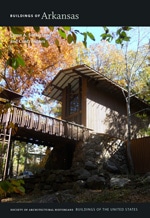Founded as the Farmer’s State Bank, the institution was incorporated in 1910 as a federally chartered, national bank. Though the architect is not known, the sophistication of the brick building’s Romanesque Revival features show the designer was well acquainted with the style, evidenced in the rusticated limestone window arches and sills, the wide stone band between the first and second stories, and the corbeled cornice. An expansion of the bank in the 1920s included a remodeling of the building’s exterior. The bank failed in the financial crash of 1929 and the building remained unoccupied for many years, until acquired by First National Bank in the 1970s, and then by Arvest. Around the corner at 110 N. Mt. Olive Street, the community hall (1934), formerly the American Legion Hall, is a Works Progress Administration (WPA)–built rugged gable-fronted building of random-sized stone.
You are here
Arvest Bank (First National Bank, Farmer’s State Bank)
If SAH Archipedia has been useful to you, please consider supporting it.
SAH Archipedia tells the story of the United States through its buildings, landscapes, and cities. This freely available resource empowers the public with authoritative knowledge that deepens their understanding and appreciation of the built environment. But the Society of Architectural Historians, which created SAH Archipedia with University of Virginia Press, needs your support to maintain the high-caliber research, writing, photography, cartography, editing, design, and programming that make SAH Archipedia a trusted online resource available to all who value the history of place, heritage tourism, and learning.















